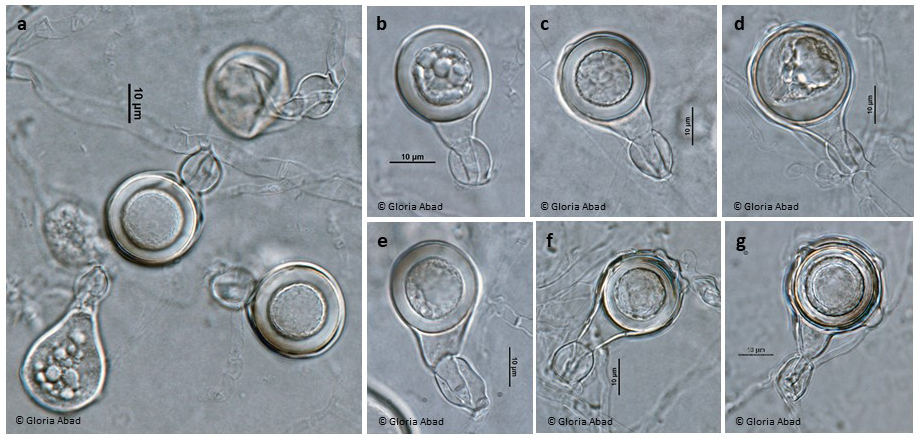Phytophthora cocois
|
Phytophthora spp. in Clade 5: portion of the seven-loci ML phylogeny featuring the type cultures of 212 described species (by T. Bourret). Notice the position of P. cocois Ex-type CBS 149822 = S&T BL 157. Gloria Abad, USDA S&T.
|
|
Phytophthora spp. in Clade 5: Morphological Tabular key (PDF) and Tabular key legends (PDF) in IDphy2 KEY SECTION. Notice the data of P. cocois Ex-type CBS 149822 = S&T BL 157. Gloria Abad, USDA S&T.
|
|
Phytophthora cocois (CPHST BL 157) colonies of the ex-type grown for 7 days on (a) V8® Agar, (b) potato dextrose agar, and (c) malt extract agar; photo by Krysta Jennings and Leandra Knight, USDA-APHIS-PPQ |
|
Phytophthora cocois (ex-type CPHST BL 157) sexual phase (a–g): (a–g) oogonia with amphigynous antheridia and plerotic oospores, (b–g) with tapered bases, (f, g) oogonia with typical moderately bullate protuberances; photos by Gloria Abad, USDA-APHIS-PPQ |
Name and publication
Phytophthora cocois B.S. Weir, Beever, Pennycook, Bellgard & J.Y. Uchida (2015)
Weir BS, Paredes EP, Anand N, Uchida JY, Shaun R, Pennycook SEB, and Beever RE. 2015. A taxonomic revision of Phytophthora Clade clade:
a taxonomic group of organisms classified together on the basis of homologous features traced to a common ancestor
5 including two new species, Phytophthora agathidicida and P. cocois. Phytotaxa 205: 21–38 (pg. 32).
Corresponding author: WeirB@LandcareResearch.co.nz
Nomenclature
from Weir et al. (2015)
Mycobank
Index Fungorum
Etymology
Latin genitive noun: cocois—of Cocos
Typification
Type: UNITED STATES OF AMERICA. Hawaii: Kauai, from diseased fruit (husk) of Cocos nucifera L., J.Y. Uchida H1024, May 1990, dried culture specimen, PDD 103199 [PDD = New Zealand Fungal and Plant Disease Fungarium (New Zealand)]
Ex-type: ICMP 16948 living culture preserved in a metabolically inactive state [ICMP = International Collection of Microorganisms from Plants (New Zealand)]
Sequences for ex-type in original manuscript: Phytophthora cocois ICMP 16948 = ITS KP295304, COX1 KP295220, YPT1 KP295423, HSP90 KP295274, L10 KP295361, ENL KP295252, ND1 KP295332, TIGA KP295390
Ex-type in other collections
(ET) CBS 149822, NRRL 64369, ICMP 16948, WPC P19948, S&T BL 157 (Abad), 67D6 (Hong)
Molecular identification
Voucher sequences for barcoding genes (ITS rDNA and COI) of the ex-type (see Molecular protocols page)
Phytophthora cocois isolate CPHST BL 157 (= P19948 WPC) = ITS rDNA MG865478, COI MH136874
Voucher sequences for Molecular Toolbox with seven genes (ITS, β-tub, COI, EF1α, HSP90, L10, and YPT1
(see Molecular protocols page) (In Progress)
Voucher sequences for Metabarcoding High-throughput Sequencing (HTS) Technologies [Molecular Operational Taxonomic Unit (MOTU)]
(see Molecular protocols page) (In Progress)
Sequences with multiple genes for ex-type in other sources
- NCBI: Phytophthora cocois CPHST BL 157
- NCBI: Phytophthora cocois ICMP 16948
- EPPO-Q-bank: Phytophthora cocois
- BOLDSYSTEMS: Phytophthora cocois GBMIN43861-15 = ICMP 16948 [COI-5P:660] (barcoding COI & ITS)
Position in multigenic phylogeny with 7 genes (ITS, β-tub, COI, EF1α, HSP90, L10, and YPT1)
Clade clade:
a taxonomic group of organisms classified together on the basis of homologous features traced to a common ancestor
5
Morphological identification
adapted from Weir et al. (2015)
Colonies and cardinal temperatures
Colony colony:
assemblage of hyphae which usually develops form a single source and grows in a coordinated way
morphology after 7 days on V8-A, PDA, MEA with no distinct pattern. Minimum growth temperature 10°C; optimum 22°C, and maximum 30°C.
Asexual phase
Sporangia are papillatepapillate:
pertaining to the production of a distinct papilla at the distal end of the sporangium (cf. nonpapillate and semipapillate)
, persistentpersistent:
pertaining to sporangia that remain attached to the sporangiophore and do not separate or detach easily (cf. caducous)
, globoseglobose:
having a rounded form resembling that of a sphere
to ovoidovoid:
egg-shaped, with the widest part at the base of the sporangium and the narrow part at the apex
(17–50 x 12–35 μm), produced in short individual sporangiophores. Hyphal swellings absent. ChlamydosporesChlamydospores:
an asexual spore with a thickened inner wall that is delimited from the mycelium by a septum; may be terminal or intercalary, and survives for long periods in soil
absent.
Sexual phase
Homothallic. Oogonia are globoseglobose:
having a rounded form resembling that of a sphere
(22–35 μm diam) with moderately bullate protuberances and with tapered bases; antheridiaantheridia:
the male gametangium; a multinucleate, swollen hyphal tip affixed firmly to the wall of the female gametangium (the oogonium)
amphigynousamphigynous:
pertaining to the sexual stage in which the antheridium completely surrounds the stalk of the oogonium (cf. paragynous)
, globoseglobose:
having a rounded form resembling that of a sphere
, and often strongly reflexed (bent); and oosporesoospores:
zygote or thick-walled spore that forms within the oogonium after fertilization by the antheridium; may be long-lived
pleroticplerotic:
pertaining to an oospore that fills the oogonium (cf. aplerotic)
nearly filling the oogoniaoogonia:
the female gametangium in which the oospore forms after fertilization by the antheridium
(20–30 μm diam).
Most typical characters
Phytophthora cocois is characterized by the presence of oogoniaoogonia:
the female gametangium in which the oospore forms after fertilization by the antheridium
with mildly bullate ornamented walls and tapered bases formed abundantly on V8A.
Additional specimen evaluated
Phytophthora cocois ex-type CPHST BL 157, duplicate of P19948 (World Phytophthora Collection), which is a duplicate of ex-type ICMP 16948
Hosts and distribution
Distribution: Hawaii, Africa (Ivory Coast)
Substrate: fruit, leaves
Disease note: frond death, wilting, fruit rot, tree death
Host: Cocos nucifera (Arecaceae), possibly Theobroma cacao (Malvaceae)
Retrieved January 29, 2018 from U.S. National Fungus Collections Nomenclature Database.
Additional references and links
- SMML USDA-ARS: Phytophthora cocois
- EPPO Global Database: Phytophthora cocois
- Forest Phytophthoras of the World: Phytophthora cocois
- CABI Digital Library: Phytophthora cocois
- Encyclopedia of Life (EOL): Phytophthora cocois
- Index Fungorum (IF): Phytophthora cocois
- Google All Phytophthora cocois
- Google Images Phytophthora cocois
- Google Scholar Phytophthora cocois
Fact sheet author
Z. Gloria Abad, Ph.D., USDA-APHIS-PPQ-S&T Plant Pathogen Confirmatory Diagnostics Laboratory (PPCDL), United States of America.



